Decoding Social Sustainability in Construction Projects: Analysis of Project Dynamics and Impact
Abstract
:1. Introduction
- What are the key social factors that significantly influence Construction Sustainability (CS) in developing countries?
- What causal relationships exist among the identified social factors affecting CS in developing countries?
- How can a System Dynamics Model (SDM) be developed to capture the complexity of implementing CS, focusing on the social aspects?
- To identify and list the key social factors affecting CS in developing countries.
- To determine the causality among identified factors and their interconnectivity and develop a CLD to apprehend the causes and effects.
- To develop an SDM to address the complexity in the implementation of CS with a focus on the social aspect.
2. Literature Review
2.1. Sustainable Development and Construction Sustainability
2.2. Stakeholders Involvement
2.3. Social Aspects in Construction Sustainability
2.4. Wide Spectrum of Social Sustainability
2.5. Complexity and Social Construction Sustainability
2.6. System Dynamics and Social Construction Sustainability
- Identify and analyze the feedback loops of the social factors affecting CS.
- Develop and understand the cause-and-effect relationships of social CS factors.
- Understand the nonlinear dynamics and complex relationships of the variables in the system.
- Evaluate the long-term impacts of policies and interventions to address the social CS.
- Identify potential trade-offs and unintended consequences of the social factors.
- Formulate a mathematical representation of the system and simulate its behavior over time.
3. Methodology
3.1. Literature Analysis and Systematic Review (PRISMA)
3.2. Desk Study Phase
3.3. Data Collection and Analysis Phases
3.3.1. Preliminary Survey Phase
3.3.2. Sample Size
3.3.3. Detailed Survey Phase
| Type | Frequency | Percentage | |
|---|---|---|---|
| Organization | Academia | 29 | 26.3% |
| Client | 21 | 19.1% | |
| Consultant | 22 | 20% | |
| Contractor | 33 | 30% | |
| Client/Consultant | 3 | 2.7% | |
| Consultant/Academia | 2 | 1.9% | |
| Professional Experience (Years) | 0–1 | 1 | 0.9% |
| 1–5 | 24 | 21.8% | |
| 6–10 | 13 | 11.8% | |
| 11–15 | 26 | 23.6% | |
| 16–20 | 28 | 25.4% | |
| >20 | 18 | 16.5% | |
| Designation | Project Director | 14 | 12.7% |
| Construction Manage | 18 | 16.3% | |
| Resident Engineer | 9 | 8.2% | |
| Planning Engineer | 17 | 15.4% | |
| Educationist | 14 | 12.7% | |
| Researcher | 23 | 20.9% | |
| Architect/Designer | 5 | 4.5% | |
| Site Engineer | 8 | 7.5% | |
| BIM Engineer | 2 | 1.8% | |
| Understanding sustainable construction | No understanding at all | 5 | 4.5% |
| Slight | 20 | 18.2% | |
| Moderate | 58 | 52.7% | |
| Exceptional | 27 | 24.5% |
3.3.4. Systems Thinking and System Dynamics Modeling Phase
4. Results and Discussion
4.1. Relationship and Polarity Matrix (RPM)
4.2. Causal Loop Diagram (CLD)
4.2.1. Reinforcing Loop R8 (Enhancing Quality of Life)
4.2.2. Reinforcing Loop R1 (Cultural Preservation Initiative)
4.2.3. Reinforcing Loop R2 (Community Involvement Measure)
4.2.4. Reinforcing Loop R3 (Government Support Impacts)
4.2.5. Reinforcing Loop R4 (Resistance to Sustainability Adoption)
4.2.6. Reinforcing Loop R5 (Local Environment Enhancement)
4.2.7. Reinforcing Loop R6 (Economy Uplifting Measure)
4.2.8. Reinforcing Loop R7 (Health and Safety Measures)
4.2.9. Balancing Loop B1 (Sustainable Material Cost Controls)
4.3. Causal Loop Diagram (CLD) Analysis
4.4. System Dynamics Model
Simulation of SD Model and Discussions
4.5. Model Validation
5. Conclusions
5.1. Theoretical Implications
5.2. Practical Implications
Author Contributions
Funding
Data Availability Statement
Conflicts of Interest
References
- Do, N. How to Create Cultural Clusters in Historical Regions. 2006. Available online: https://www.diva-portal.org/smash/get/diva2:828588/FULLTEXT01.pdf (accessed on 28 February 2024).
- Pérez-Lombard, L.; Ortiz, J.; Pout, C. A Review on Buildings Energy Consumption Information. Energy Build. 2008, 40, 394–398. [Google Scholar] [CrossRef]
- Gražulevičiūtė, I. Cultural heritage in the context of sustainable development. Environ. Res. Eng. Manag. 2006, 37, 74–79. [Google Scholar]
- Pepper, C. Sustainability of Cultural Heritage and Landscapes; Edward Elgar Publishing: London, UK, 2006. [Google Scholar]
- Ajayi, S.O.; Oyedele, L.O.; Akinade, O.O.; Bilal, M.; Alaka, H.A.; Owolabi, H.A.; Kadiri, K. Attributes of design for construction waste minimization: A case study of waste-to-energy project. Renew. Sustain. Energy Rev. 2017, 73, 1333–1341. [Google Scholar] [CrossRef]
- Tam, V.W.Y.; Tam, C.M.; Zeng, S.X. Towards adoption of sustainable practices in construction: A conceptual framework. Sustain. Dev. 2007, 42, 3642–3654. [Google Scholar]
- Huovila, P.; Airaksinen, M. Reducing the carbon footprint of construction projects by using integrated digital project delivery. Int. J. Sustain. Build. Technol. Urban Dev. 2018, 9, 214–227. [Google Scholar]
- Guo, J.-X. Cleaner technology choice in the synergistic control process for greenhouse gases and air pollutions. J. Clean. Prod. 2019, 238, 117885. [Google Scholar] [CrossRef]
- Åsa Casula Vifell, L.S. Organizing matters: How ‘the social dimension’ gets lost in sustainability projects. Sustain. Dev. 2012, 20, 18–27. [Google Scholar] [CrossRef]
- Surbeck, C.Q.; Hilger, H. Social Sustainability and Important Indicators in Infrastructure. In Proceedings of the World Environmental and Water Resources Congress 2014, Portland, OR, USA, 1–5 June 2014. [Google Scholar]
- Awadh, O. Sustainability and green building rating systems: LEED, BREEAM, GSAS and Estidama critical analysis. J. Build. Eng. 2017, 11, 25–29. [Google Scholar] [CrossRef]
- Shan, M.; Hwang, B.G. Green Building Rating Systems: Global Reviews of Practices and Research Efforts. Sustain. Cities Soc. 2018, 39, 172–180. [Google Scholar] [CrossRef]
- Hariram, N.P.; Mekha, K.B.; Suganthan, V.; Sudhakar, K. Sustainalism: An Integrated Socio-Economic-Environmental Model to Address Sustainable Development and Sustainability. Sustainability 2023, 15, 10682. [Google Scholar] [CrossRef]
- Rostamnezhad, M.; Thaheem, M.J. Social Sustainability in Construction Projects—A Systematic Review of Assessment Indicators and Taxonomy. Sustainability 2022, 14, 5279. [Google Scholar] [CrossRef]
- Manseau, A.; Dresner, M. Social sustainability in the construction sector. In Social Sustainability in the Global Supply Chain; Nesheim, C.S., Dresner, M., Manseau, A., Eds.; Routledge: Abingdon, UK, 2017. [Google Scholar]
- Fatourehchi, D.; Zarghami, E. Social sustainability assessment framework for managing sustainable construction in residential buildings. J. Build. Eng. 2020, 32, 101761. [Google Scholar] [CrossRef]
- Eizenberg, E.; Jabareen, Y. Social Sustainability: A New Conceptual Framework. Sustainability 2017, 9, 68. [Google Scholar] [CrossRef]
- Charles, J. Kibert, Sustainable Construction: Green Building Design and Delivery, 3rd ed.; John Wiley & Sons: Hoboken, NJ, USA, 2012; ISBN 9780470904459. [Google Scholar]
- Page, M.J.; McKenzie, J.E.; Bossuyt, P.M.; Boutron, I.; Hoffmann, T.C.; Mulrow, C.D.; Shamseer, L.; Tetzlaff, J.M.; Akl, E.A.; Brennan, S.E.; et al. The PRISMA statement: An updated guideline for reporting systematic reviews. Int. J. Surg. 2021, 88, 105906. [Google Scholar]
- Forrester, J.W. Industrial dynamics. J. Oper. Res. Soc. 1997, 48, 1037–1041. [Google Scholar] [CrossRef]
- Chaerul, M.; Tanaka, M.; Shekdar, A.V. A system dynamics approach for hospital waste management. Waste Manag. 2008, 28, 442–449. [Google Scholar] [CrossRef]
- Missimer, M.; Robèrt, K.-H.; Broman, G. A strategic approach to social sustainability—Part 1: Exploring the social system. J. Clean. Prod. 2017, 140, 32–41. [Google Scholar] [CrossRef]
- Gou, Z.; Xie, X. Evolving green building: Triple bottom line or regenerative design? J. Clean. Prod. 2017, 153, 600–607. [Google Scholar] [CrossRef]
- Diaz-Sarachaga, J.M.; Jato-Espino, D.; Alsulami, B.; Castro-Fresno, D. Evaluation of existing sustainable infrastructure rating systems for their application in developing countries. Ecol. Indic. 2016, 71, 491–502. [Google Scholar] [CrossRef]
- Almahmoud, E.; Doloi, H. Social sustainability health check: A model for integrating stakeholders’ interests in evaluating and optimising social sustainability performance of construction projects. In Proceedings of the CIB International Conference, Valledacqua, Italy, 9–15 September 2012. [Google Scholar]
- Knight, D.; Pearce, C.L.; Smith, K.G.; Olian, J.D.; Sims, H.P.; Smith, K.A.; Flood, P. Top management team diversity, group process, and strategic consensus. Strateg. Manag. J. 1999, 20, 445–465. [Google Scholar] [CrossRef]
- Rohracher, H. Managing the technological transition to sustainable construction of buildings: A socio-technical perspective. Technol. Anal. Strateg. Manag. 2001, 13, 137–150. [Google Scholar] [CrossRef]
- Kaatz, E.; Root, D.; Bowen, P. Broadening project participation through a modified building sustainability assessment. Build. Res. Inf. 2005, 33, 441–454. [Google Scholar] [CrossRef]
- Ekwo, U.S. Sustainability through collaboration-based corporate social responsibility. In Proceedings of the AEI 2013: Building Solutions for Architectural Engineering, State College, PA, USA, 3–5 April 2013; pp. 633–642. [Google Scholar]
- Miyatake, Y. Technology development and sustainable construction. J. Manag. Eng. 1996, 12, 23–27. [Google Scholar] [CrossRef]
- Mihelcic, J.R.; Crittenden, J.C.; Small, M.J.; Shonnard, D.R.; Hokanson, D.R.; Zhang, Q.; Chen, H.; Sorby, S.A.; James, V.U.; Sutherland, J.W.; et al. Sustainability science and engineering: The emergence of a new metadiscipline. Environ. Sci. Technol. 2003, 37, 5314–5324. [Google Scholar] [CrossRef] [PubMed]
- Boström, M. A missing pillar? Challenges in theorizing and practicing social sustainability: Introduction to the special issue. Sustain. Sci. Pract. Policy 2012, 8, 3–14. [Google Scholar] [CrossRef]
- Wan, L.; Ng, E. Evaluation of the social dimension of sustainability in the built environment in poor rural areas of China. Archit. Sci. Rev. 2018, 61, 319–326. [Google Scholar] [CrossRef]
- Ahmad, T.; Thaheem, M.J. Developing a residential building-related social sustainability assessment framework and its implications for BIM. Sustain. Cities Soc. 2017, 28, 1–15. [Google Scholar] [CrossRef]
- Valdes-Vasquez, R.; Klotz, L. Considering social dimensions of sustainability during construction project planning and design. Int. J. Environ. Cult. Econ. Soc. Sustain. 2010, 6, 167–180. [Google Scholar] [CrossRef]
- Alyami, S.H.; Rezgui, Y.; Kwan, A. Developing sustainable building assessment scheme for Saudi Arabia: Delphi consultation approach. Renew. Sustain. Energy Rev. 2013, 27, 43–54. [Google Scholar] [CrossRef]
- Sahely, H.R.; A Kennedy, C.; Adams, B.J. Developing sustainability criteria for urban infrastructure systems. Can. J. Civ. Eng. 2005, 32, 72–85. [Google Scholar] [CrossRef]
- Sierra, L.A.; Yepes, V.; Pellicer, E. A review of multi-criteria assessment of the social sustainability of infrastructures. J. Clean. Prod. 2018, 187, 496–513. [Google Scholar] [CrossRef]
- Atanda, J.O. Developing a social sustainability assessment framework. Sustain. Cities Soc. 2019, 44, 237–252. [Google Scholar] [CrossRef]
- Atanda, J.O.; Öztürk, A. Social criteria of sustainable development in relation to green building assessment tools. Environ. Dev. Sustain. 2020, 22, 61–87. [Google Scholar] [CrossRef]
- Palich, N.; Edmonds, A. Social sustainability: Creating places and participatory processes that perform well for people. In Environment Design Guide; Royal Australian Institute of Architects: Melbourne, Australia, 2013; pp. 1–13. [Google Scholar]
- Lindman, Å.; Ranängen, H.; Kauppila, O. Guiding corporate social responsibility practice for social license to operate: A Nordic mining perspective. Extr. Ind. Soc. 2020, 7, 892–907. [Google Scholar] [CrossRef]
- Behm, M. Linking construction fatalities to the design for construction safety concept. Saf. Sci. 2005, 43, 589–611. [Google Scholar] [CrossRef]
- Labuschagne, C.; Brent, A.C.; van Erck, R.P. Assessing the sustainability performances of industries. J. Clean. Prod. 2005, 13, 373–385. [Google Scholar] [CrossRef]
- Toole, T.M.; Carpenter, G. Prevention through design as a path toward social sustainability. J. Archit. Eng. 2013, 19, 168–173. [Google Scholar] [CrossRef]
- Valdes-Vasquez, R.; Klotz, L. Incorporating the social dimension of sustainability into civil engineering education. J. Prof. Issues Eng. Educ. Pract. 2011, 137, 189–197. [Google Scholar] [CrossRef]
- Bramley, G.; Dempsey, N.; Power, S.; Brown, C. What is ‘social sustainability’, and how do our existing urban forms perform in nurturing it. In Proceedings of the Sustainable Communities and Green Futures’ Conference, London, UK, 5–7 April 2006. [Google Scholar]
- Hammer, J. Development that adds up: Accounting for the social bottom line of triple bottom line investment. In Social Equity and Opportunity Forum; College of Urban and Public Affairs, Portland State University: Portland, OR, USA, 2009. [Google Scholar]
- Lamprinidi, S.; Ringland, L. A Snapshot of Sustainability Reporting in the Construction and Real Estate Sector; Global Reporting Initiative: Amsterdam, The Netherlands, 2008. [Google Scholar]
- Almahmoud, E.; Doloi, H.K. Assessment of social sustainability in construction projects using social network analysis. Facilities 2015, 33, 152–176. [Google Scholar] [CrossRef]
- Vanclay, F. The triple bottom line and impact assessment: How do TBL, EIA, SIA, SEA and EMS relate to each other? J. Environ. Assess. Policy Manag. 2004, 6, 265–288. [Google Scholar] [CrossRef]
- Rasul, N.; Malik, M.S.A.; Bakhtawar, B.; Thaheem, M.J. Risk assessment of fast-track projects: A systems-based approach. Int. J. Constr. Manag. 2021, 21, 1099–1114. [Google Scholar] [CrossRef]
- Ullah, F. A beginner’s guide to developing review-based conceptual frameworks in the built environment. Architecture 2021, 1, 5–24. [Google Scholar] [CrossRef]
- Ullah, F.; Qayyum, S.; Thaheem, M.J.; Al-Turjman, F.; Sepasgozar, S.M. Risk management in sustainable smart cities governance: A TOE framework. Technol. Forecast. Soc. Change 2021, 167, 120743. [Google Scholar] [CrossRef]
- Ullah, F.; Sepasgozar, S.M.E.; Wang, C. A systematic review of smart real estate technology: Drivers of, and barriers to, the use of digital disruptive technologies and online platforms. Sustainability 2018, 10, 3142. [Google Scholar] [CrossRef]
- Ullah, F.; Al-Turjman, F. A conceptual framework for blockchain smart contract adoption to manage real estate deals in smart cities. Neural Comput. Appl. 2023, 35, 5033–5054. [Google Scholar] [CrossRef]
- Azman, N.S.; Ramli, M.Z.; Razman, R.; Zawawi, M.H.; Ismail, I.N.; Isa, M.R. Relative importance index (RII) in ranking of quality factors on industrialised building system (IBS) projects in Malaysia. In Proceedings of the AIP Conference, Bodrum, Turkey, 4–8 September 2019; AIP Publishing LLC: Melville, NY, USA, 2019. [Google Scholar]
- Gan, X.; Zuo, J.; Ye, K.; Skitmore, M.; Xiong, B. Why sustainable construction? Why not? An owner’s perspective. Habitat Int. 2015, 47, 61–68. [Google Scholar] [CrossRef]
- Banihashemi, S.; Hosseini, M.R.; Golizadeh, H.; Sankaran, S. Critical success factors (CSFs) for integration of sustainability into construction project management practices in developing countries. Int. J. Proj. Manag. 2017, 35, 1103–1119. [Google Scholar] [CrossRef]
- Yang, R.J.; Zou, P.X. Stakeholder-associated risks and their interactions in complex green building projects: A social network model. Build. Environ. 2014, 73, 208–222. [Google Scholar] [CrossRef]
- Chang, R.-D.; Zuo, J.; Zhao, Z.-Y.; Soebarto, V.; Lu, Y.; Zillante, G.; Gan, X.-L. Sustainability attitude and performance of construction enterprises: A China study. J. Clean. Prod. 2018, 172, 1440–1451. [Google Scholar] [CrossRef]
- Saleh, M.S.; Alalouch, C. Towards sustainable construction in Oman: Challenges & opportunities. Procedia Eng. 2015, 118, 177–184. [Google Scholar]
- Shafii, F.; Ali, Z.A.; Othman, M.Z. Achieving sustainable construction in the developing countries of Southeast Asia. In Proceedings of the 6th Asia-Pacific Structural Engineering and Construction Conference, Kuala Lumpur, Malaysia, 5–6 September 2006. [Google Scholar]
- Tokbolat, S.; Karaca, F.; Durdyev, S.; Calay, R.K. Construction professionals’ perspectives on drivers and barriers of sustainable construction. Environ. Dev. Sustain. 2020, 22, 4361–4378. [Google Scholar] [CrossRef]
- Whang, S.-W.; Kim, S. Balanced sustainable implementation in the construction industry: The perspective of Korean contractors. Energy Build. 2015, 96, 76–85. [Google Scholar] [CrossRef]
- Chen, Y.; Okudan, G.E.; Riley, D.R. Sustainable performance criteria for construction method selection in concrete buildings. Autom. Constr. 2010, 19, 235–244. [Google Scholar] [CrossRef]
- Shen, L.-Y.; Hao, J.L.; Tam, V.W.-Y.; Yao, H. A checklist for assessing sustainability performance of construction projects. J. Civ. Eng. Manag. 2007, 13, 273–281. [Google Scholar] [CrossRef]
- Osuizugbo, I.C.; Oyeyipo, O.; Lahanmi, A.; Morakinyo, A.; Olaniyi, O. Barriers to the adoption of sustainable construction. Eur. J. Sustain. Dev. 2020, 9, 150. [Google Scholar] [CrossRef]
- Shen, L.Y.; Wu, Y.Z.; Chan, E.H.W.; Hao, J.L. Application of system dynamics for assessment of sustainable performance of construction projects. J. Zhejiang Univ.-Sci. A 2005, 6, 339–349. [Google Scholar] [CrossRef]
- Wang, L.; Zhang, P.; Ma, L.; Cong, X.; Skibniewski, M.J. Developing a corporate social responsibility framework for sustainable construction using partial least squares structural equation modeling. Technol. Econ. Dev. Econ. 2020, 26, 186–212. [Google Scholar] [CrossRef]
- Bamgbade, J.; Kamaruddeen, A.; Nawi, M. Malaysian construction firms’ social sustainability via organizational innovativeness and government support: The mediating role of market culture. J. Clean. Prod. 2017, 154, 114–124. [Google Scholar] [CrossRef]
- Carvajal-Arango, D.; Bahamón-Jaramillo, S.; Aristizábal-Monsalve, P.; Vásquez-Hernández, A.; Botero, L.F.B. Relationships between lean and sustainable construction: Positive impacts of lean practices over sustainability during construction phase. J. Clean. Prod. 2019, 234, 1322–1337. [Google Scholar] [CrossRef]
- Gilchrist, A.; Allouche, E.N. Quantification of social costs associated with construction projects: State-of-the-art review. Tunn. Undergr. Space Technol. 2005, 20, 89–104. [Google Scholar] [CrossRef]
- Nasirzadeh, F.; Ghayoumian, M.; Khanzadi, M.; Cherati, M.R. Modelling the social dimension of sustainable development using fuzzy cognitive maps. Int. J. Constr. Manag. 2020, 20, 223–236. [Google Scholar] [CrossRef]
- Taheriattar, R.; Farzanehrafat, M. Construction Managers’ Perception of the Factors Affecting Sustainability in Construction Projects. Int. J. Sustain. Constr. Eng. Technol. 2014, 5, 22–32. [Google Scholar]
- Yao, H.; Shen, L.; Tan, Y.; Hao, J. Simulating the impacts of policy scenarios on the sustainability performance of infrastructure projects. Autom. Constr. 2011, 20, 1060–1069. [Google Scholar] [CrossRef]
- Gudienė, N.; Banaitis, A.; Podvezko, V.; Banaitienė, N. Identification and evaluation of the critical success factors for construction projects in Lithuania: AHP approach. J. Civ. Eng. Manag. 2014, 20, 350–359. [Google Scholar] [CrossRef]
- Yu, T.; Shi, Q.; Zuo, J.; Chen, R. Critical factors for implementing sustainable construction practice in HOPSCA projects: A case study in China. Sustain. Cities Soc. 2018, 37, 93–103. [Google Scholar] [CrossRef]
- Lam, P.T.I.; Chan, E.H.W.; Poon, C.S.; Chau, C.K.; Chun, K.P. Factors affecting the implementation of green specifications in construction. J. Environ. Manag. 2010, 91, 654–661. [Google Scholar] [CrossRef] [PubMed]
- Ghufran, M.; Khan, K.I.A.; Ullah, F.; Nasir, A.R.; Al Alahmadi, A.A.; Alzaed, A.N.; Alwetaishi, M. Circular economy in the construction industry: A step towards sustainable development. Buildings 2022, 12, 1004. [Google Scholar] [CrossRef]
- Riaz, H.; Khan, K.I.A.; Ullah, F.; Tahir, M.B.; Alqurashi, M.; Alsulami, B.T. Key factors for implementation of total quality management in construction Sector: A system dynamics approach. Ain Shams Eng. J. 2023, 14, 101903. [Google Scholar] [CrossRef]
- Amin, F.; Khan, K.I.A.; Ullah, F.; Alqurashi, M.; Alsulami, B.T. Key Adoption Factors for Collaborative Technologies and Barriers to Information Management in Construction Supply Chains: A System Dynamics Approach. Buildings 2022, 12, 766. [Google Scholar] [CrossRef]
- Dominik Paprotny, R.D.P. Convergence Between Developed and Developing Countries: A Centennial Perspective. Soc. Indic. Res. 2020, 153, 193–225. [Google Scholar] [CrossRef] [PubMed]
- Jahan, S.; Khan, K.I.A.; Thaheem, M.J.; Ullah, F.; Alqurashi, M.; Alsulami, B.T. Modeling Profitability-Influencing Risk Factors for Construction Projects: A System Dynamics Approach. Buildings 2022, 12, 701. [Google Scholar] [CrossRef]
- Ghufran, M.; Khan, K.I.A.; Thaheem, M.J.; Nasir, A.R.; Ullah, F. Adoption of Sustainable Supply Chain Management for Performance Improvement in the Construction Industry: A System Dynamics Approach. Architecture 2021, 1, 161–182. [Google Scholar] [CrossRef]
- Rostow, W.W. Rostow’s Stages of Economic Growth Theory; Routledge: Abingdon, UK, 1960. [Google Scholar]
- Abbas, J.; Aman, J.; Nurunnabi, M.; Bano, S. The Impact of Social Media on Learning Behavior for Sustainable Education: Evidence of Students from Selected Universities in Pakistan. Sustainability 2019, 11, 1683. [Google Scholar] [CrossRef]
- Malterud, K.; Siersma, V.D.; Guassora, A.D. Sample size in qualitative interview studies: Guided by information power. Qual. Health Res. 2016, 26, 1753–1760. [Google Scholar] [CrossRef]
- Taber, K.S. The use of Cronbach’s alpha when developing and reporting research instruments in science education. Res. Sci. Educ. 2018, 48, 1273–1296. [Google Scholar] [CrossRef]
- Chen, D.; Zhang, T.; Zhao, L. An Adaptive Cluster Validity Index Based on Fuzzy Set. In Proceedings of the 2012 International Conference on Industrial Control and Electronics Engineering, Xi’an, China, 23–25 August 2012; IEEE: New York, NY, USA, 2012. [Google Scholar]
- World Economic Forum. The Inclusive Development Index 2018 Summary and Data Highlights; World Economic Forum: Geneva, Switzerland, 2018; Available online: https://www3.weforum.org/docs/WEF_Forum_IncGrwth_2018.pdf (accessed on 28 February 2024).
- Bertassini, A.C.; Zanon, L.G.; Azarias, J.G.; Gerolamo, M.C.; Ometto, A.R. Circular Business Ecosystem Innovation: A guide for mapping stakeholders, capturing values, and finding new opportunities. Sustain. Prod. Consum. 2021, 27, 436–448. [Google Scholar] [CrossRef]
- Senge, P.M. The Fifth Discipline: The Art and Practice of the Learning Organization; Broadway Business: Manhattan, NY, USA, 2006. [Google Scholar]
- Dresner, S. The Principles of Sustainability; Routledge: Abingdon, UK, 2012. [Google Scholar]
- Heath, R.L.; Palenchar, M.J. Strategic Issues Management: Organizations and Public Policy Challenges; Sage Publications: New York, NY, USA, 2008. [Google Scholar]
- Berkes, F. Community-based conservation in a globalized world. Proc. Natl. Acad. Sci. USA 2007, 104, 15188–15193. [Google Scholar] [CrossRef] [PubMed]
- Li, X.; Chen, Y.; Chen, Y.; Geng, Y. Promoting sustainable construction in China: The role of government, market dynamics, and social awareness. Resour. Conserv. Recycl. 2021, 174, 105810. [Google Scholar]
- Susskind, L.E.; McKearnen, S.; Thomas-Lamar, J. The Consensus Building Handbook: A Comprehensive Guide to Reaching Agreement; Sage Publications: New York, NY, USA, 1999. [Google Scholar]
- Larson, E.W.; Gray, C.F. Project Management the Managerial Process; Mc Graw Hill Companies, Inc.: New York, NY, USA, 2011. [Google Scholar]
- Mitchell, R.K.; Agle, B.R.; Wood, D.J. Toward a theory of stakeholder identification and salience: Defining the principle of who and what really counts. Acad. Manag. Rev. 1997, 22, 853–886. [Google Scholar] [CrossRef]
- Turner, J.R. The Handbook of Project-Based Management; McGraw-Hill Companies, Inc.: New York, NY, USA, 2009. [Google Scholar]
- Mebratu, D. Sustainability and sustainable development: Historical and conceptual review. Environ. Impact Assess. Rev. 1998, 18, 493–520. [Google Scholar] [CrossRef]
- Jordan, A.; Lenschow, A. Innovation in environmental policy? Integrating environment and sustainability in EU external relations. Environ. Plan. C Gov. Policy 2010, 28, 830–846. [Google Scholar]
- Wu, W.G.; Shen, L.; Yen, B.P. Economic incentives and sustainable construction: Evidence from government financial incentives for green building in China. Habitat Int. 2019, 87, 101989. [Google Scholar]
- Lam, P.T.; Chan, E.H.; Chan, D.W. Barriers to the adoption of green building technologies: The views of stakeholders in Hong Kong. Constr. Manag. Econ. 2012, 30, 453–472. [Google Scholar]
- Leppelt, T.; Birkmann, J. From resistant to resilient: A conceptual framework for minimizing urban resilience implementation gaps. Sustainability 2019, 11, 4980. [Google Scholar]
- Johnson, M.; Hansson, J. The role of policy instruments in shaping stakeholder attitudes towards sustainability in the construction industry. J. Clean. Prod. 2016, 112 Pt 1, 1100. [Google Scholar]
- Walker, C.; Redmond, J.; Mokhtarian, P.L. Determinants of individuals’ acceptance of sustainable building technologies. Transp. Res. Part D Transp. Environ. 2015, 41, 315–328. [Google Scholar]
- Liu, H.; Hua, T.; Li, J.; Wu, P. A conceptual framework for promoting the sustainable behavior of occupants in green buildings. Sustain. Cities Soc. 2019, 44, 354–362. [Google Scholar]
- Kunz, M.; Birkmann, J. Resilience-oriented adaptation in urban planning and governance: A conceptual framework. Sustainability 2018, 10, 1793. [Google Scholar]
- Jabeen, S.; Pradhan, B.; Shoujun, M.; Khatri, D.B.; Shahab, S. Measuring construction and demolition waste management practices in the construction industry of Pakistan. J. Clean. Prod. 2019, 239, 118087. [Google Scholar]
- Chen, H.; Wu, Z.; Wang, X.; Yuan, H. Exploring factors influencing construction waste management efforts in China: A structural equation modeling approach. J. Clean. Prod. 2016, 112, 751–762. [Google Scholar]
- Ding, G.K. Sustainable construction—The role of environmental assessment tools. J. Environ. Manag. 2008, 86, 451–464. [Google Scholar] [CrossRef] [PubMed]
- De Medeiros, D.S.; Gonçalves, M.C. Proposal for a method to evaluate the impacts on the quality of life in sustainable construction projects. Habitat Int. 2014, 42, 53–59. [Google Scholar]
- Mostafa, T.; Rollo, J. The impact of stakeholder engagement on sustainability outcomes in the construction sector. Sustainability 2016, 8, 469. [Google Scholar]
- Wu, P.; Low, S.P.; Goh, B.H.; Tan, E.Y. Sustainability in the construction industry: A review of recent developments and future prospects. Sustain. Prod. Consum. 2018, 13, 159–172. [Google Scholar]
- Irizarry, J.; Rapoza, C. Sustainability assessment of construction project through Fuzzy-AHP. Procedia Eng. 2017, 196, 815–822. [Google Scholar]
- Dastbaz, M.; Fernando, T.; Underwood, J. Understanding the drivers for the adoption of sustainable building practices. J. Build. Perform. 2017, 8, 4–14. [Google Scholar]
- van den Dobbelsteen, A.; Sassi, P.; Mlecnik, E. The potential of local initiatives for urban sustainability. Energy Procedia 2015, 78, 2592–2597. [Google Scholar]
- Chan, A.P.; Lam, P.T.; Chan, D.W. Impact of government policy on the performance of green construction projects. J. Manag. Eng. 2019, 35, 04018094. [Google Scholar]
- Ballesteros-Pérez, P.; Rubio-Romero, J.C.; López-Arquillos, A. Safety in construction: A comprehensive description based on Rasmussen’s risk management framework. Saf. Sci. 2017, 92, 99–112. [Google Scholar]
- Pacheco-Torgal, F.; Jalali, S.; Fucic, A. Health and safety issues in sustainable construction: An overview. Procedia Eng. 2017, 180, 335–342. [Google Scholar]
- Howard, J.; Capon, A.; Thompson, S. Health and sustainability: Australia in a global context. Med. J. Aust. 2016, 204, S7–S10. [Google Scholar]
- Shen, L.; Tam, V.W.; Tam, C.M.; Drew, D.S. Safety management performance in Hong Kong construction projects. J. Constr. Eng. Manag. 2013, 139, 176–188. [Google Scholar]
- Zuo, J.; Zillante, G. Barriers to the adoption of green building technologies. Sustain. Dev. 2013, 21, 325–338. [Google Scholar]
- Hossain, M.U.; Loosemore, M. Barriers to adopting sustainability in the construction industry supply chains: A study of the Bangladeshi construction industry. Sustainability 2018, 10, 1470. [Google Scholar]
- Rameezdeen, R.; Chileshe, N.; Hosseini, M.R. Government initiatives for main contractors to promote sustainability in Sri Lanka. Sustain. Dev. 2013, 21, 303–314. [Google Scholar]
- Akadiri, P.O.; Chinyio, E.A.; Olomolaiye, P.O. Design of a sustainable building: A conceptual framework for implementing sustainability in the building sector. Buildings 2012, 2, 126–152. [Google Scholar] [CrossRef]
- Liu, M.; Song, Y.; Li, W. Evaluation of government support for sustainable construction in China: A content analysis of policy documents. Sustain. Dev. 2017, 25, 3–15. [Google Scholar]
- Zou, P.X.; Hong, J.; Wang, J. Integrating safety risk factors into design for safety management in green building projects. Saf. Sci. 2019, 120, 531–541. [Google Scholar]
- Ochoa, J.J.; Iribarren, D.; Rey-Maquieira, J. Environmental assessment of construction and demolition waste management through concrete with ceramic sanitary ware waste addition. J. Clean. Prod. 2019, 219, 217–229. [Google Scholar]
- Smith, J.; Johnson, M.; Brown, A. Government policies and stakeholder awareness: Exploring the drivers of sustainable construction practices. Constr. Res. Congr. 2020, 2020, 288–297. [Google Scholar]
- Chen, Y.; Liu, H.; Lu, Y. Cultural sustainability of rural communities in China: A case study of two villages in Sichuan. Sustainability 2018, 10, 3503. [Google Scholar]
- Cao, X.; Zhao, T.; Xing, Z. How Do Government Policies Promote Green Housing Diffusion in China? A Complex Network Game Context. Int. J. Environ. Res. Public Health 2022, 19, 2238. [Google Scholar] [CrossRef] [PubMed]
- Senge, P.M.; Forrester, J.W. Tests for building confidence in system dynamics models. Syst. Dyn. TIMS Stud. Manag. Sci. 1980, 14, 209–228. [Google Scholar]


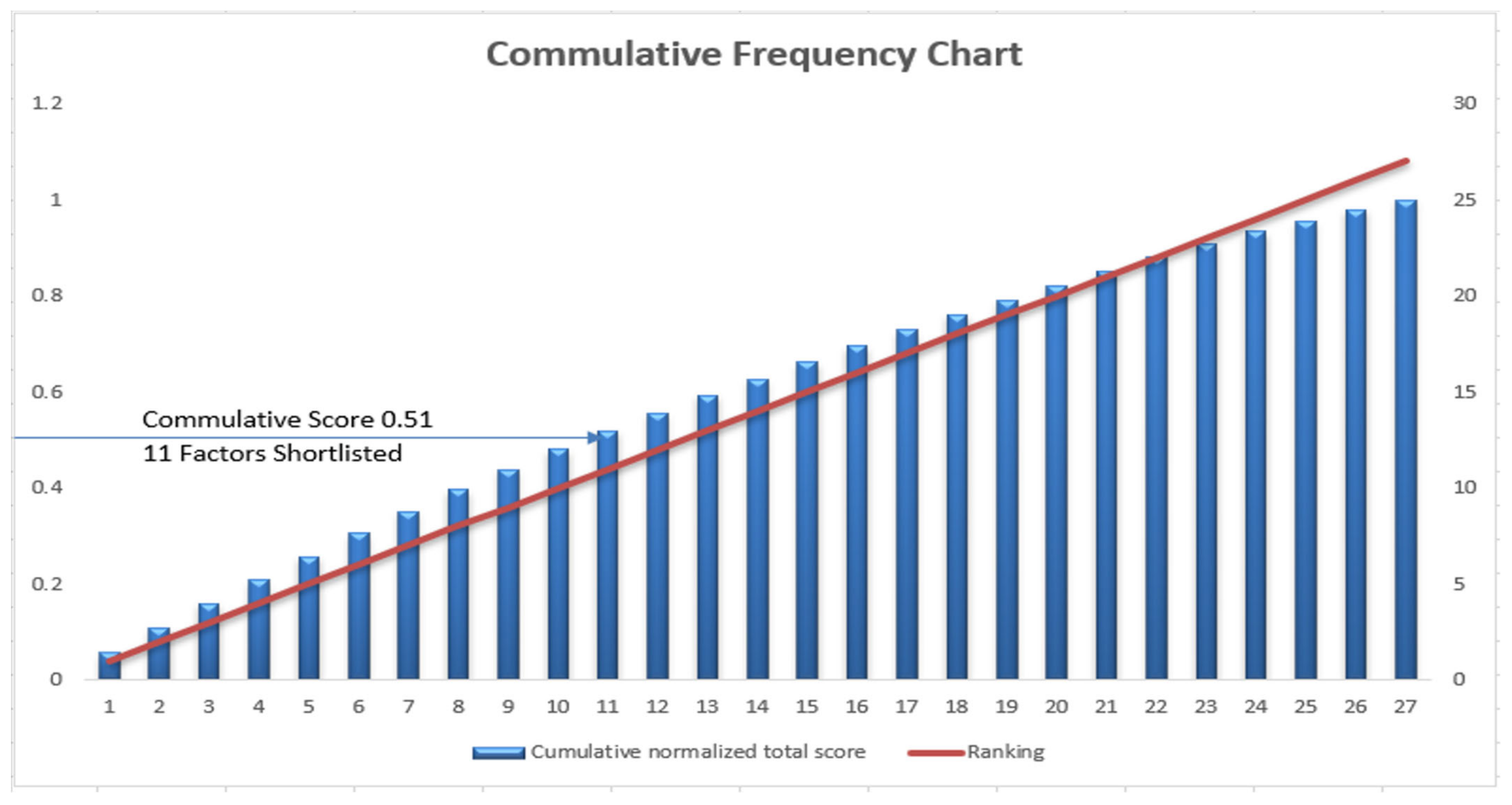
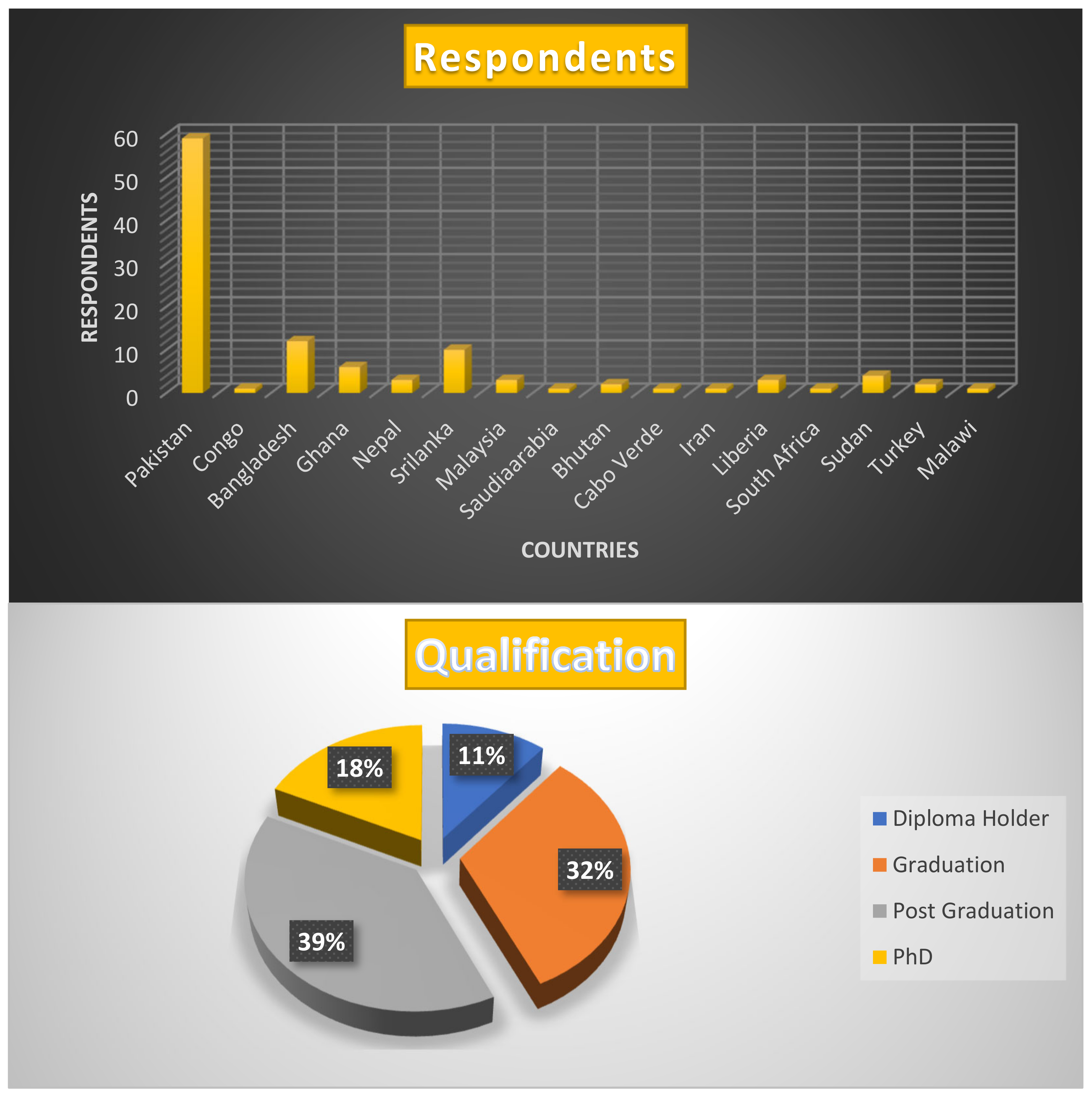
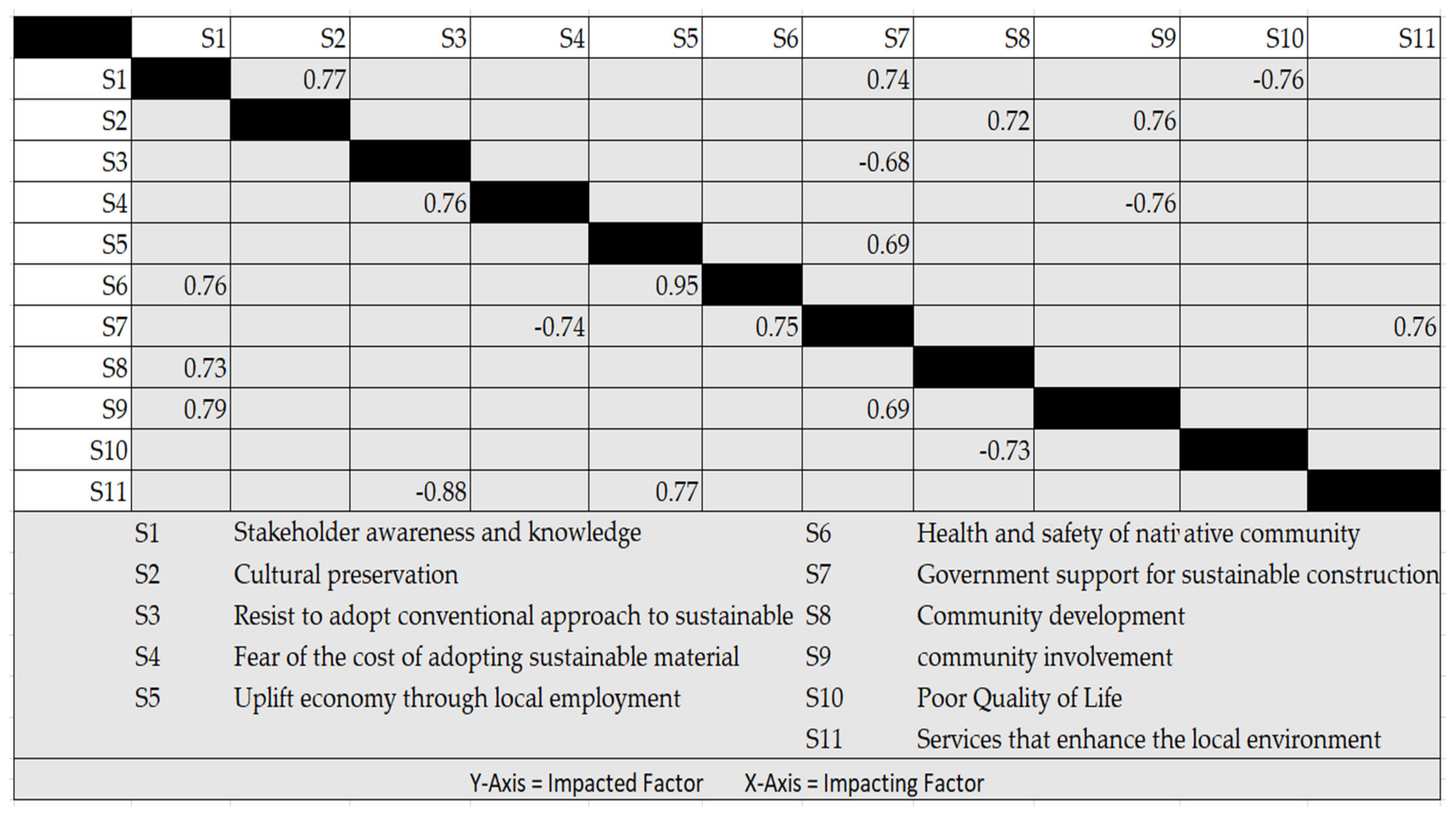
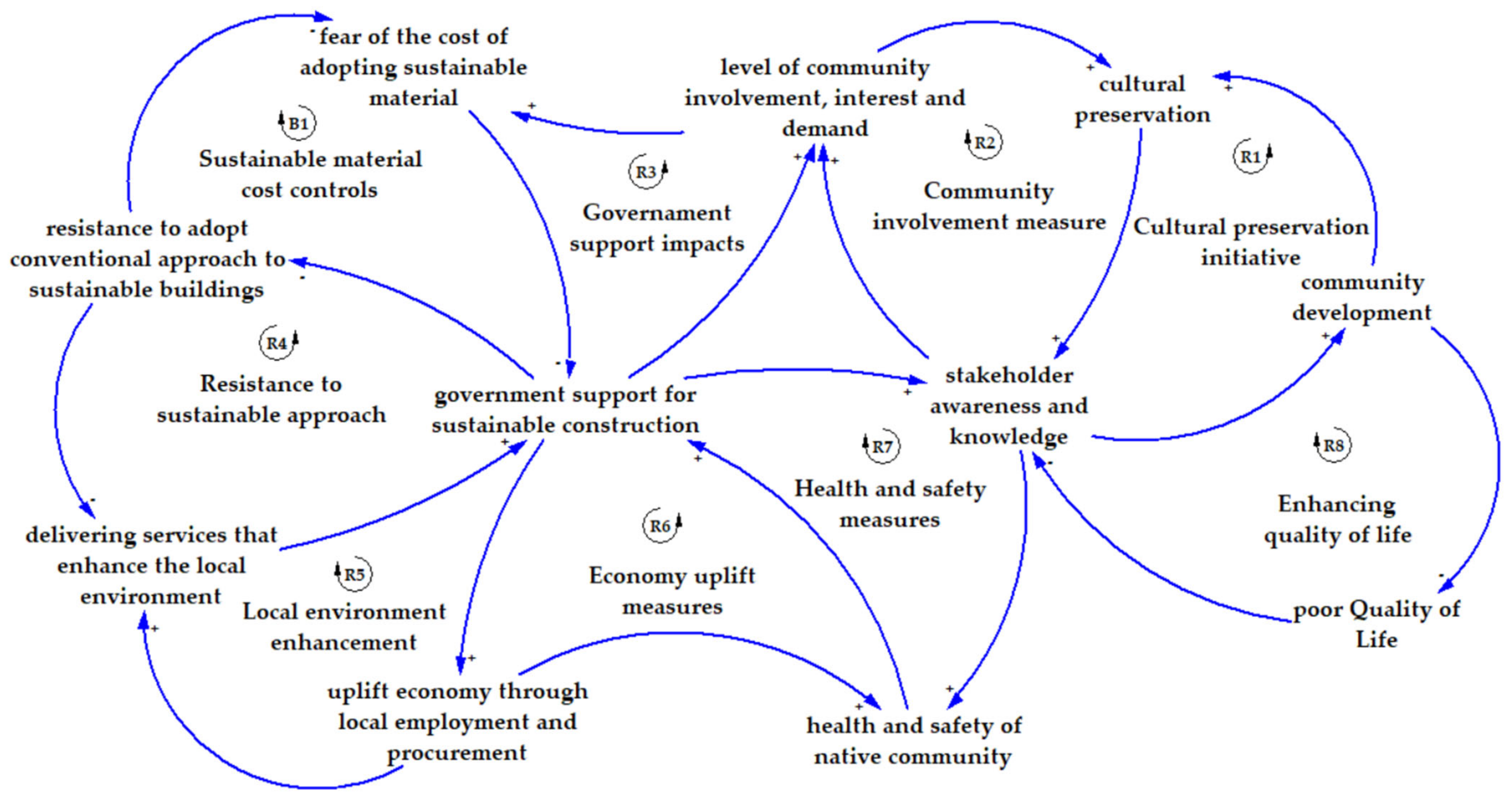

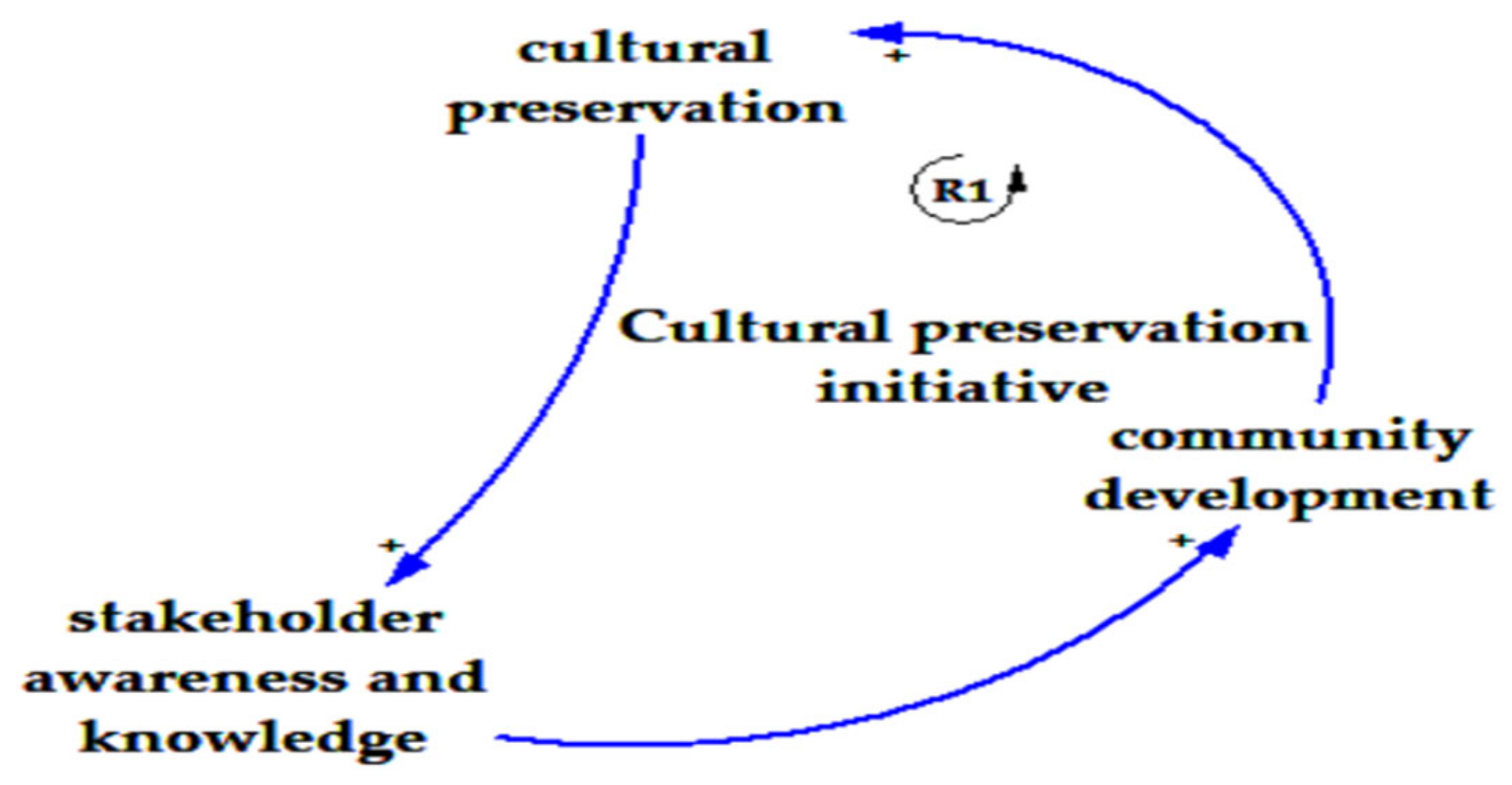

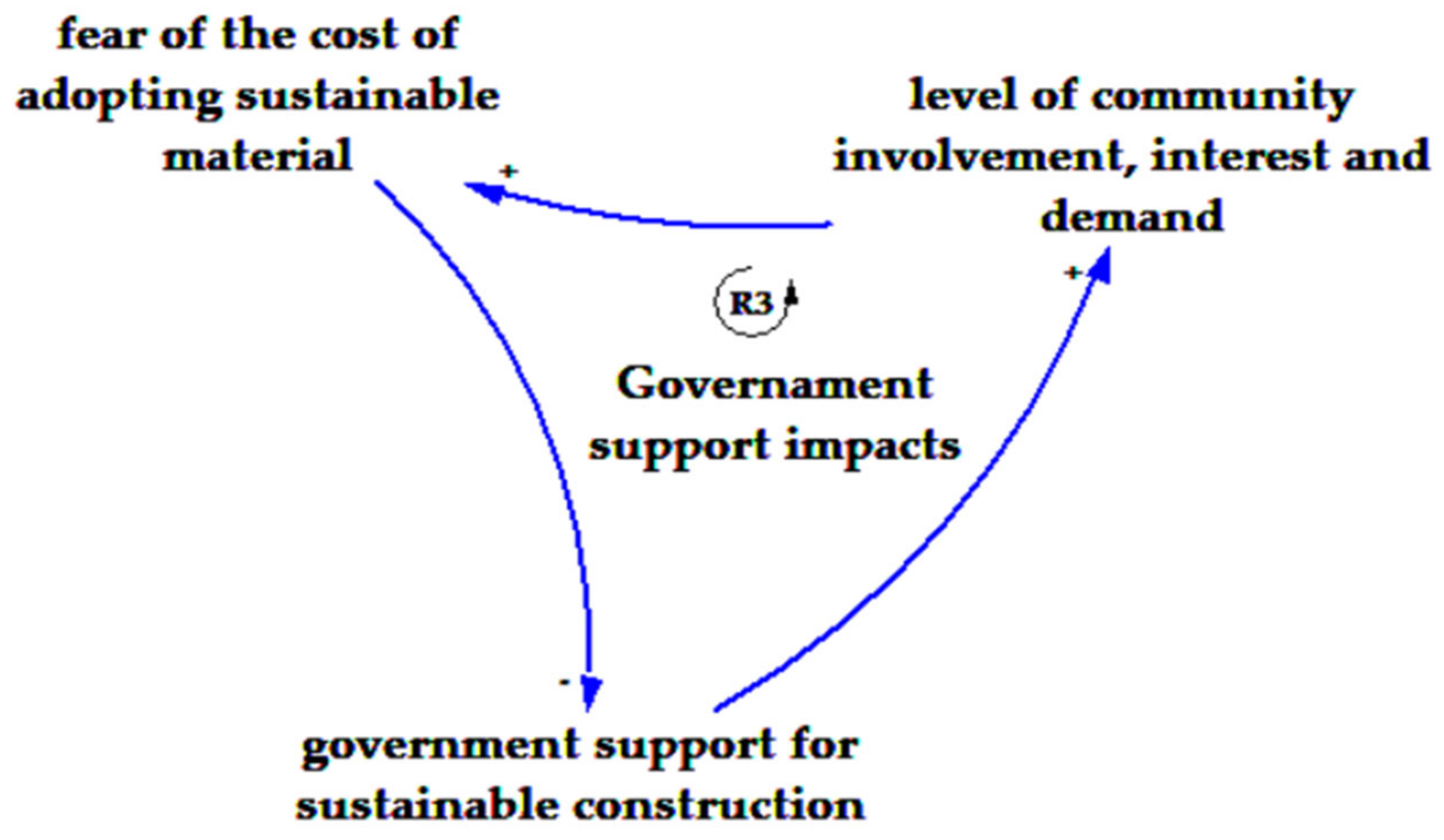
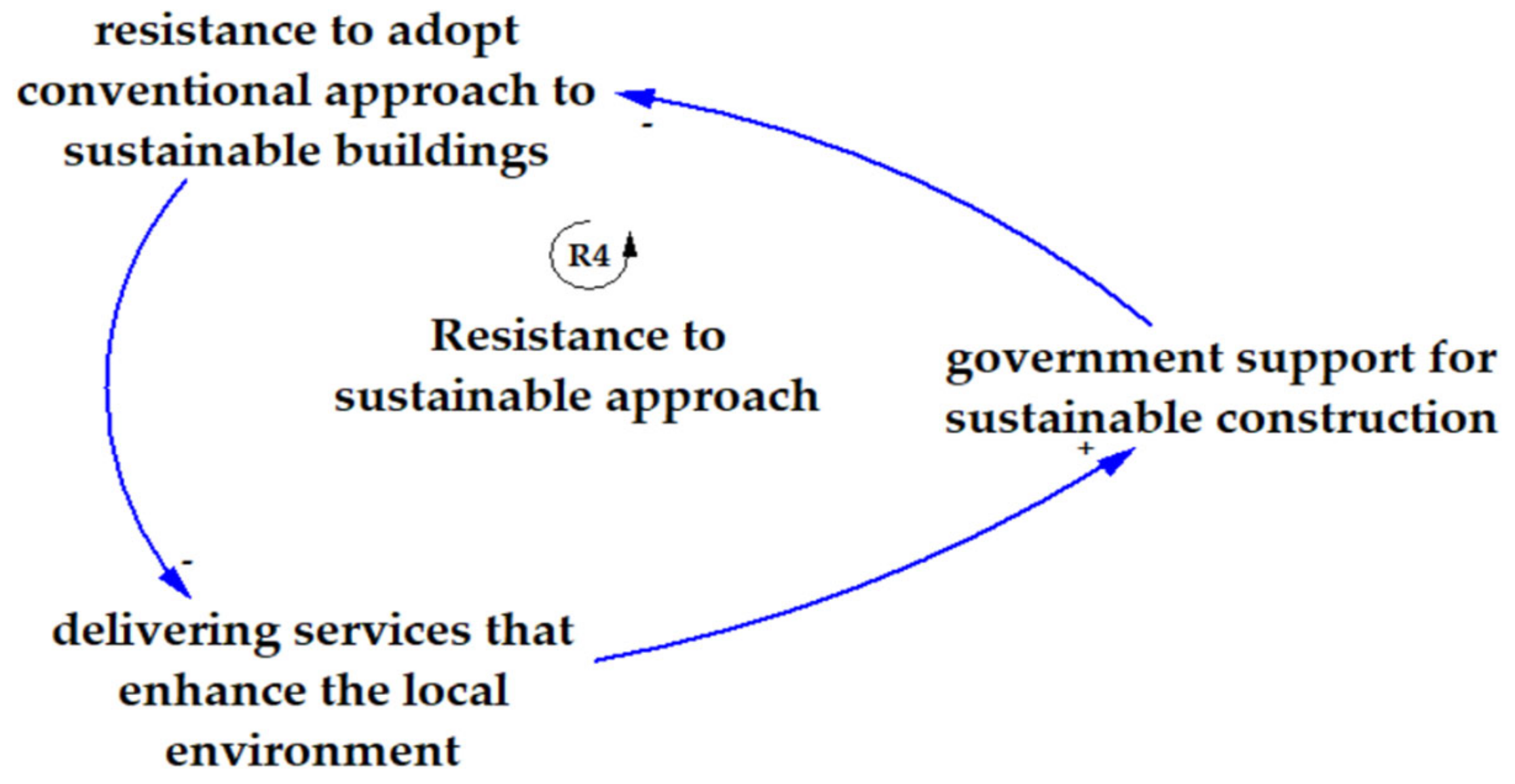
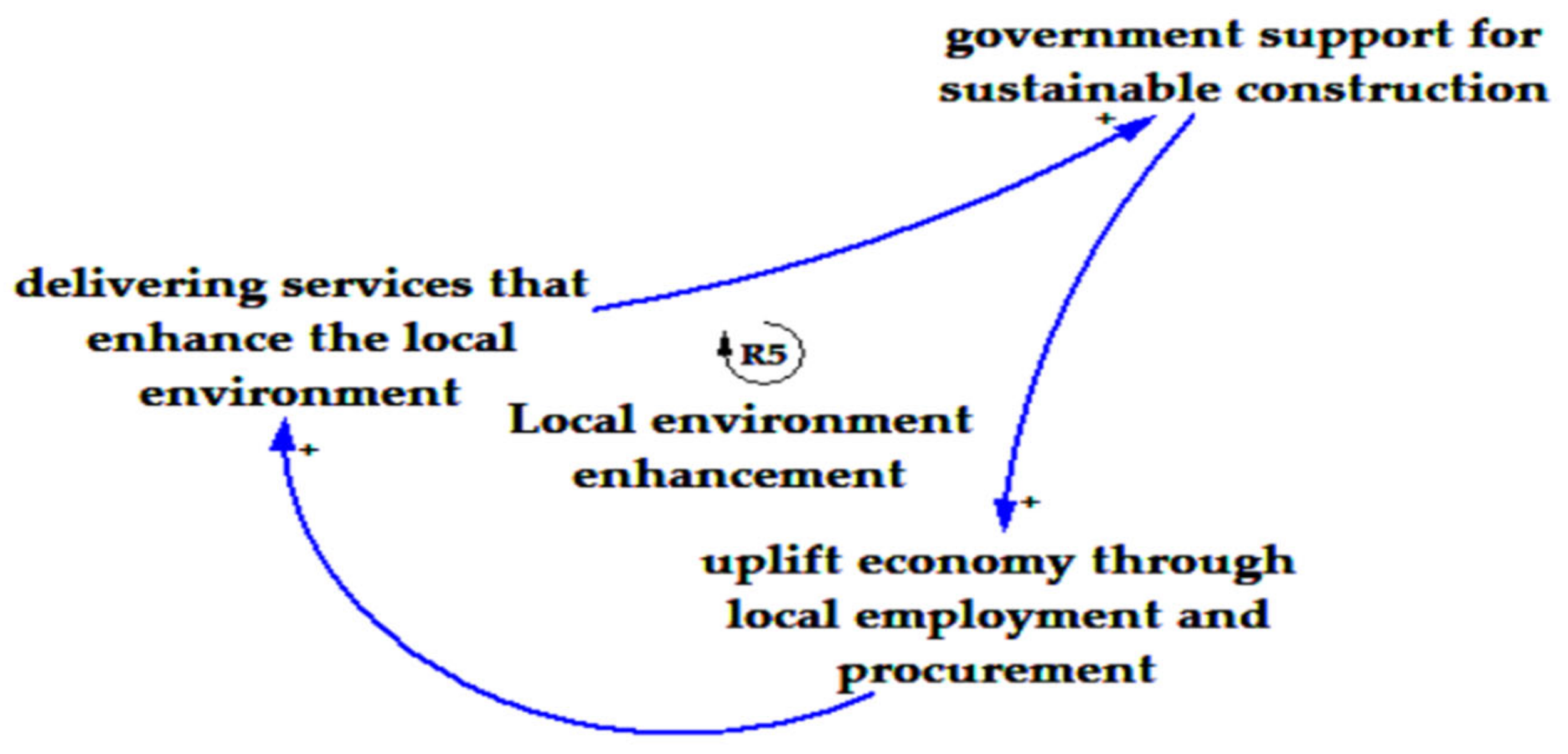
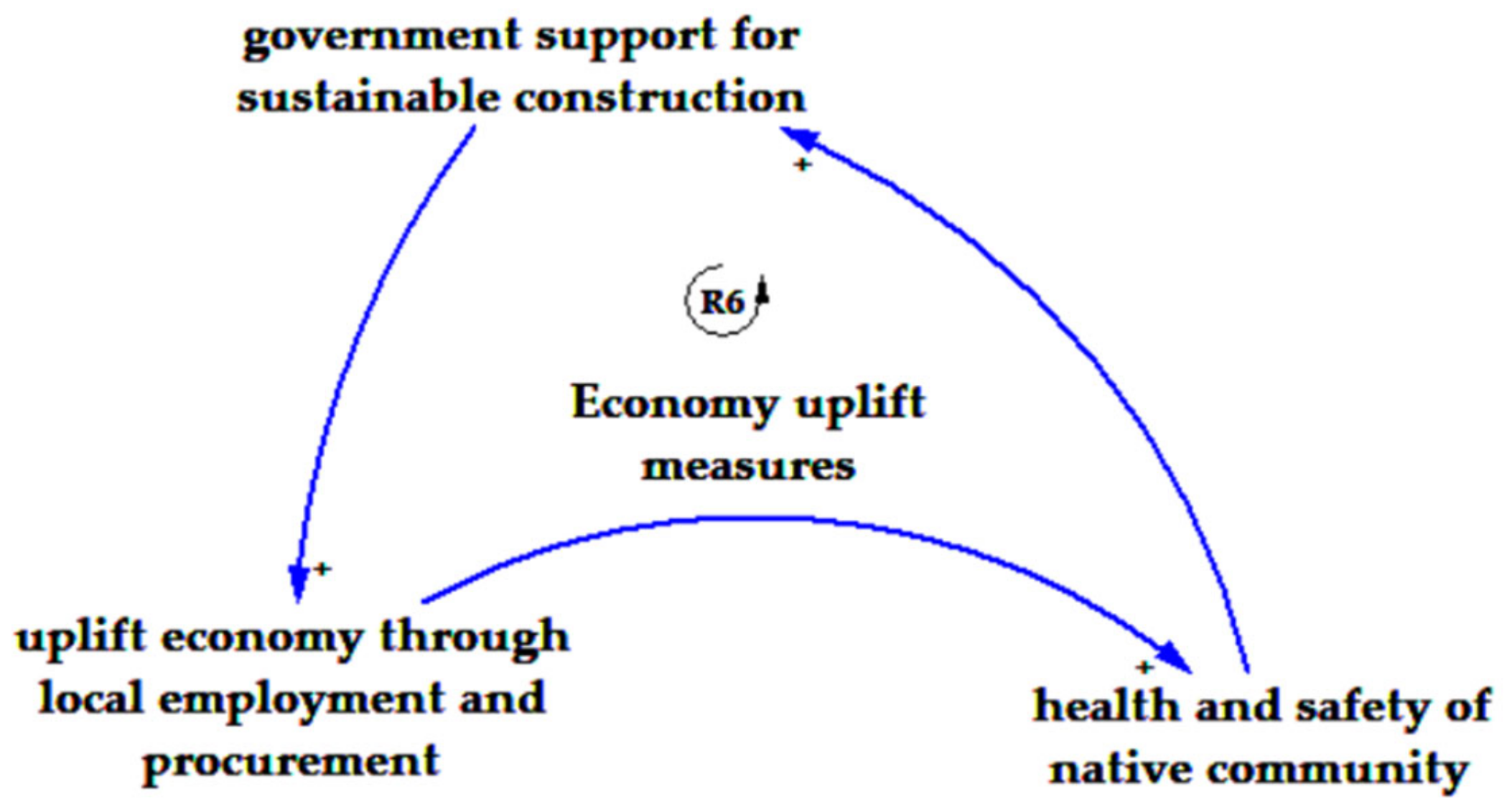
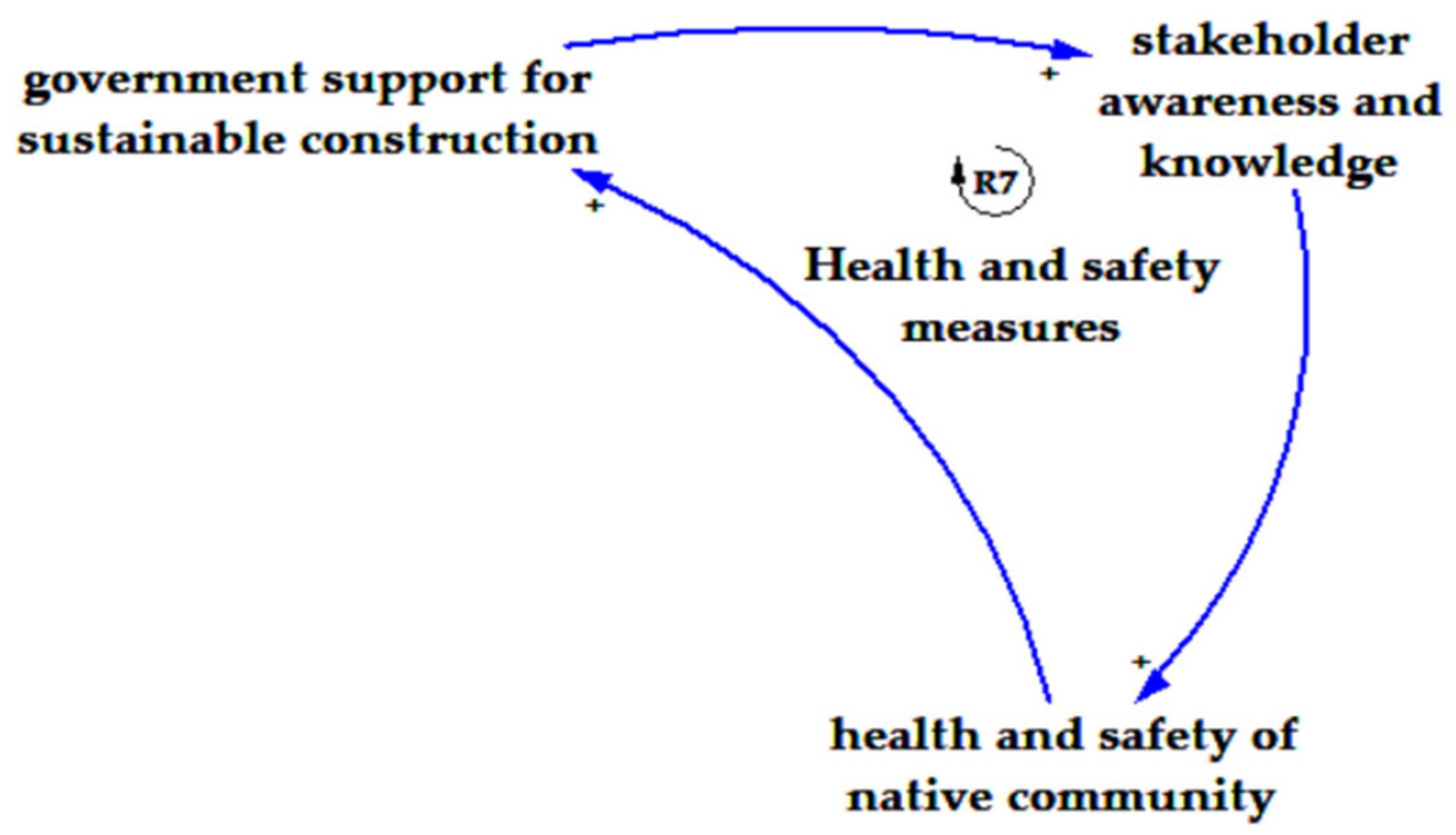
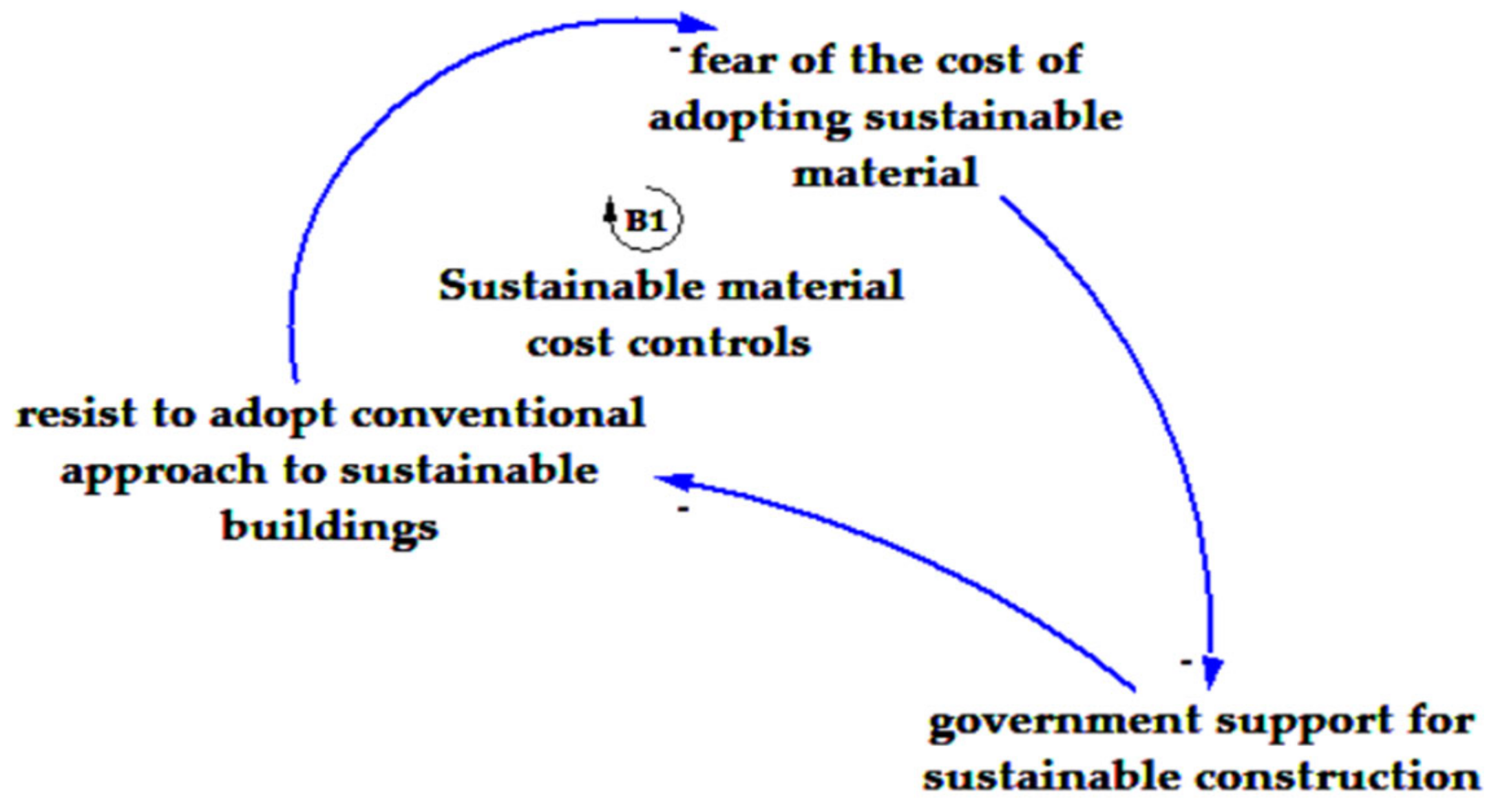
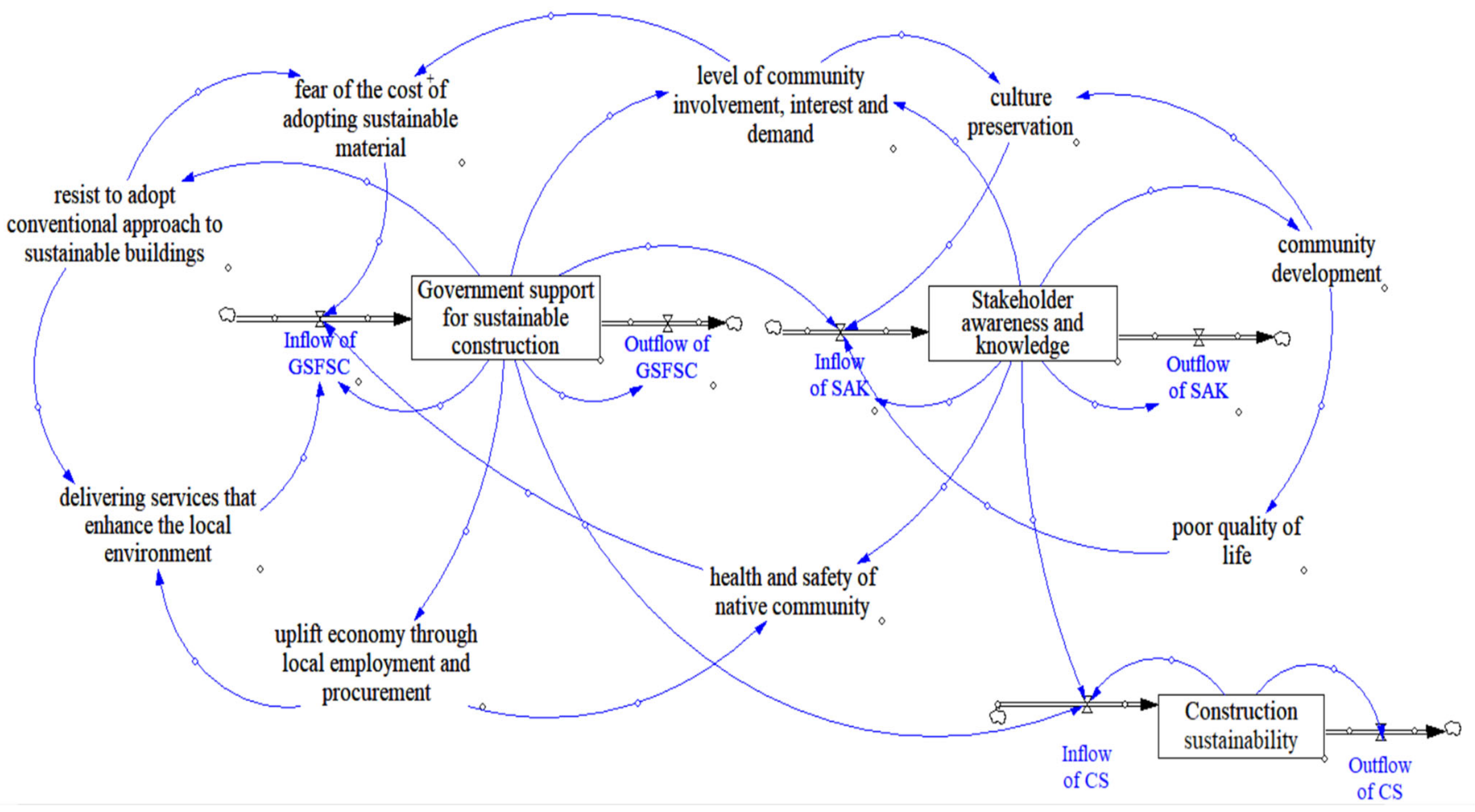
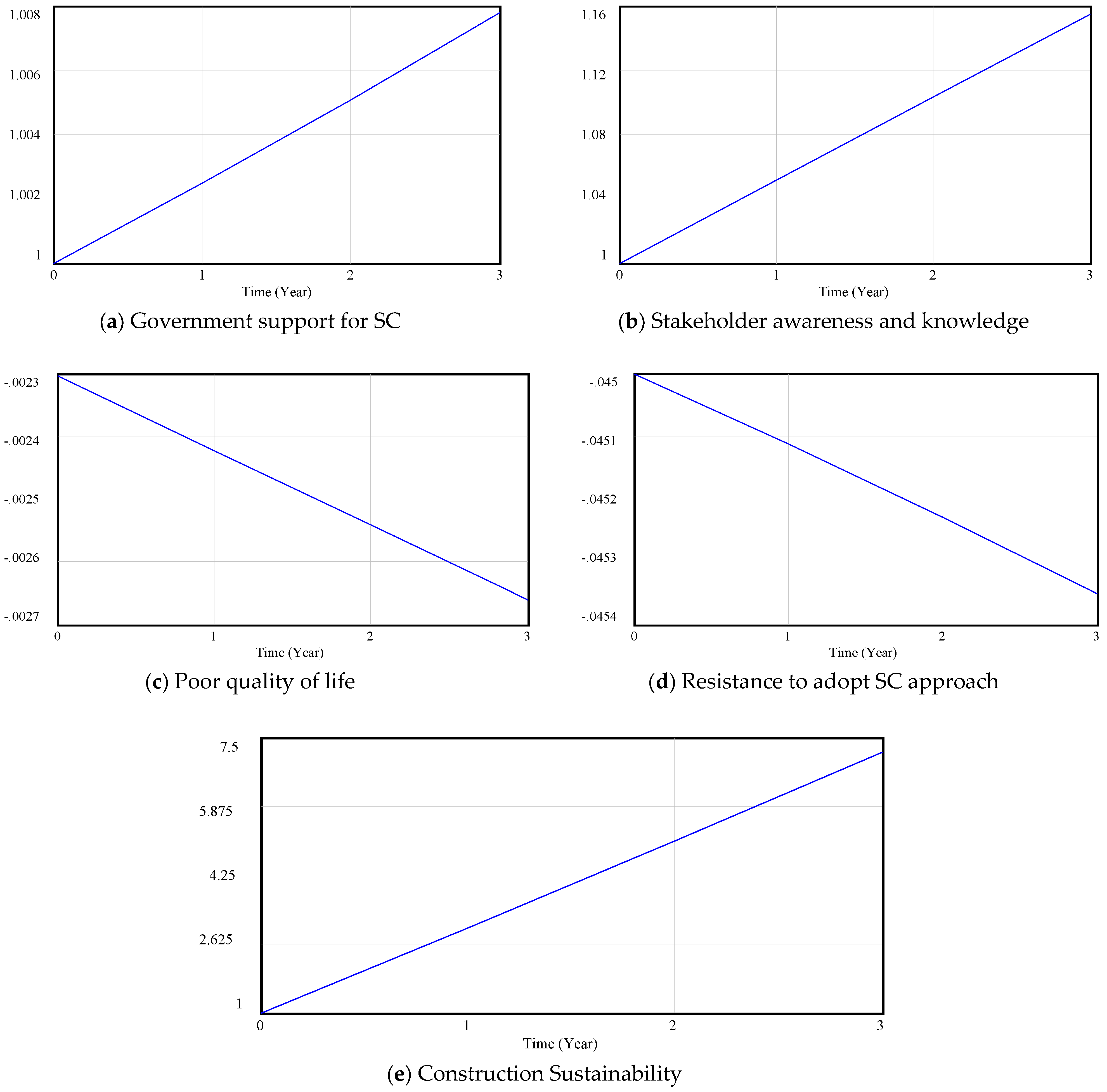
| S. No. | Social Factors Affecting Construction Sustainability | Sources |
|---|---|---|
| 1 | Stakeholder awareness and knowledge | [58,59,60,61,62,63,64] |
| 2 | Cultural preservation | [61,64,65,66,67] |
| 3 | Resistance to adopting modern approach to sustainable buildings (all stakeholders) | [61,62,64,68] |
| 4 | Fear of the cost of adopting sustainable material | [63,64] |
| 5 | Uplifting economy through local employment and procurement | [64,67,69,70] |
| 6 | Health and safety of native community | [59,61,64,65,66,67,71,72] |
| 7 | No inclination to preserve resources | [68,69] |
| 8 | Community development | [61,65,66] |
| 9 | Travel delays and congestion | [66,73,74] |
| 10 | Poor quality of life | [73,75] |
| 11 | Delivering services that enhance the local environment | [65,66,75] |
| 12 | Deterioration of historic value artifacts | [76] |
| 13 | Existing trends and cultural traditions | [77] |
| 14 | Lack of common understanding among stakeholders | [60,63] |
| 15 | Degradation of recreational facilities | [73,75] |
| 16 | Increased road accidents | [73,76] |
| 17 | Government support for sustainable construction | [60,62,74,78] |
| 18 | Native skills development | [61,70,72] |
| 19 | Physical space restriction | [66,77] |
| 20 | Native people’s comfort and satisfaction | [71] |
| 21 | Relationships and communication improvement | [16,60,72] |
| 22 | Level of community involvement, interest, and demand | [59,65,71,78,79] |
| 23 | Equality for all | [77] |
| 24 | Modification of aesthetics | [66,71] |
| 25 | Security assurance | [16,65,74] |
| 26 | Public participation in the project | [16,59,60,70,72,79] |
| 27 | Community relocation | [72,74] |
| S. No. | Factors Affecting Construction Sustainability | Normalized Field Score (FS) | Normalized Literature Score (LS) | Total Score 60%FS/40%LS | Cumulative Normalized Total Score |
|---|---|---|---|---|---|
| 1 | Stakeholder awareness and knowledge | 0.030928 | 0.096228 | 0.057048 | 0.057048 |
| 2 | Cultural preservation | 0.030928 | 0.082756 | 0.0516592 | 0.1087072 |
| 3 | Resistance to adopting modern approach to sustainable buildings | 0.041237 | 0.063510 | 0.0501462 | 0.1588534 |
| 4 | Fear of the cost of adopting sustainable material | 0.051546 | 0.046189 | 0.0494032 | 0.2082566 |
| 5 | Uplift economy through local employment and procurement | 0.041237 | 0.061586 | 0.0493766 | 0.2576332 |
| 6 | Health and safety of native community | 0.041237 | 0.057737 | 0.047837 | 0.3054702 |
| 7 | Government support for sustainable construction | 0.041237 | 0.051963 | 0.0455274 | 0.3509976 |
| 8 | Community development | 0.041237 | 0.050808 | 0.0450654 | 0.396063 |
| 9 | Level of community involvement, interest, and demand | 0.041237 | 0.042725 | 0.0418322 | 0.4378952 |
| 10 | Poor quality of life | 0.041237 | 0.042340 | 0.0416782 | 0.4795734 |
| 11 | Delivering services that enhance the local environment | 0.030928 | 0.050038 | 0.038572 | 0.5181454 |
| Sr. No. | Social Factors Affecting Construction Sustainability | Sources |
|---|---|---|
| 1 | Stakeholder awareness and knowledge | [58,59,60,61,62,63,64] |
| 2 | Cultural preservation | [61,64,65,66,67] |
| 3 | Resist to adopting conventional approach to sustainable buildings (all stakeholders) | [61,62,64,68] |
| 4 | Fear of the cost of adopting sustainable material | [63,64] |
| 5 | Uplift economy through local employment and procurement | [64,67,69,70] |
| 6 | Health and safety of native community | [59,61,64,65,66,67,71,72] |
| 7 | Community development | [61,65,66] |
| 8 | Poor quality of life | [73,75] |
| 9 | Delivering services that enhance the local environment | [65,66,75] |
| 10 | Level of community involvement, interest, and demand | [59,65,71,78,79] |
| 11 | Government support for sustainable construction | [60,62,74,78] |
| S. N. | Impacting Factor | Impacted Factor | Mean | RII | Polarity |
|---|---|---|---|---|---|
| 1 | Fear of the cost of adopting sustainable material | Government support for sustainable construction | 3.69 | −0.74 | Inverse |
| 2 | Delivering services that enhance the local environment | Government support for sustainable construction | 3.78 | 0.76 | Direct |
| 3 | Health and safety of native community | Government support for sustainable construction | 3.74 | 0.75 | Direct |
| 4 | Cultural preservation | Stakeholder awareness and knowledge | 3.85 | 0.77 | Direct |
| 5 | Poor quality of life | Stakeholder awareness and knowledge | 3.78 | −0.76 | Inverse |
| 6 | Government support for sustainable construction | Stakeholder awareness and knowledge | 3.71 | 0.74 | Direct |
| 7 | Community development | Cultural preservation | 3.61 | 0.72 | Direct |
| 8 | Level of community involvement, interest, and demand | Cultural preservation | 3.82 | 0.76 | Direct |
| 9 | Government support for sustainable construction | Resistance to adopting conventional approach to sustainable buildings | 3.40 | −0.68 | Inverse |
| 10 | Level of community involvement, interest, and demand | Fear of the cost of adopting sustainable material | 3.79 | −0.76 | Inverse |
| 11 | Resistance to adopting conventional approach to sustainable buildings | Fear of the cost of adopting sustainable material | 3.80 | 0.76 | Direct |
| 12 | Government support for sustainable construction | Uplift economy through local employment and procurement | 3.47 | 0.69 | Direct |
| 13 | Uplift economy through local employment and procurement | Health and safety of native community | 4.76 | 0.95 | Direct |
| 14 | Stakeholder awareness and knowledge | Health and safety of native community | 3.79 | 0.76 | Direct |
| 15 | Stakeholder awareness and knowledge | Community development | 3.64 | 0.73 | Direct |
| 16 | Stakeholder awareness and knowledge | Level of community involvement, interest, and demand | 3.96 | 0.79 | Direct |
| 17 | Government support for sustainable construction | Level of community involvement, interest, and demand | 3.43 | 0.69 | Direct |
| 18 | Community development | Poor quality of life | 3.66 | −0.73 | Inverse |
| 19 | Resistance to adopting conventional approach to sustainable buildings | Delivering services that enhance the local environment | 4.42 | −0.88 | Inverse |
| 20 | Uplift economy through local employment and procurement | Delivering services that enhance the local environment | 3.85 | 0.77 | Direct |
| Loop | Strength of Influence | Speed of Influence | Nature of Influence |
|---|---|---|---|
| R1 | Strong | Fast | Reinforcing |
| R2 | Strong | Fast | Reinforcing |
| R3 | Strong | Fast | Reinforcing |
| R4 | Strong | Fast | Reinforcing |
| R5 | Strong | Fast | Reinforcing |
| R6 | Strong | Fast | Reinforcing |
| R7 | Strong | Fast | Reinforcing |
| R8 | Strong | Fast | Reinforcing |
| B1 | Strong | Slow | Balancing |
Disclaimer/Publisher’s Note: The statements, opinions and data contained in all publications are solely those of the individual author(s) and contributor(s) and not of MDPI and/or the editor(s). MDPI and/or the editor(s) disclaim responsibility for any injury to people or property resulting from any ideas, methods, instructions or products referred to in the content. |
© 2024 by the authors. Licensee MDPI, Basel, Switzerland. This article is an open access article distributed under the terms and conditions of the Creative Commons Attribution (CC BY) license (https://creativecommons.org/licenses/by/4.0/).
Share and Cite
Akhtar, J.; Khan, K.I.A.; Tahir, M.B.; Ullah, F.; Waheed, A. Decoding Social Sustainability in Construction Projects: Analysis of Project Dynamics and Impact. Buildings 2024, 14, 682. https://doi.org/10.3390/buildings14030682
Akhtar J, Khan KIA, Tahir MB, Ullah F, Waheed A. Decoding Social Sustainability in Construction Projects: Analysis of Project Dynamics and Impact. Buildings. 2024; 14(3):682. https://doi.org/10.3390/buildings14030682
Chicago/Turabian StyleAkhtar, Junaid, Khurram Iqbal Ahmad Khan, Muhammad Bilal Tahir, Fahim Ullah, and Abdul Waheed. 2024. "Decoding Social Sustainability in Construction Projects: Analysis of Project Dynamics and Impact" Buildings 14, no. 3: 682. https://doi.org/10.3390/buildings14030682
APA StyleAkhtar, J., Khan, K. I. A., Tahir, M. B., Ullah, F., & Waheed, A. (2024). Decoding Social Sustainability in Construction Projects: Analysis of Project Dynamics and Impact. Buildings, 14(3), 682. https://doi.org/10.3390/buildings14030682








